15 Flowers That Will Help You Achieve the Cottage Garden of Your Dreams
If you love the look of a lush cottage garden overflowing with color, consider growing these cottage garden plants.
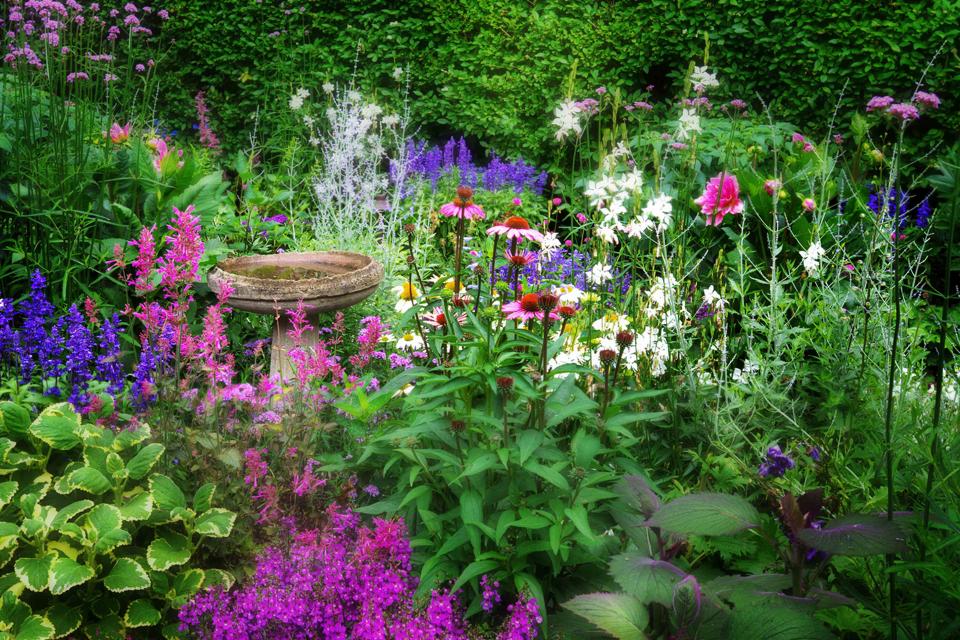
Vicki Jauron, Babylon and Beyond Photography
A cottage garden is all about maximizing interest while still being functional—traditionally, it's an English style of gardening synonymous with dense clusters of plants and a mix of edibles and ornamentals. Creating a cottage garden can be simple if you first consider leaf shape and plant height and then concentrate on flower color.
“Cottage gardening is very whimsical and looks unplanned,” says Laura Irish-Hanson from the University of Minnesota Extension. "But there is absolutely planning that’s involved with these gardens. Everything is about color and texture and space."
Ahead, we've rounded up our favorite flowers and plants to create a charming, whimsical cottage garden right in your own yard.
Meet Our Expert
Laura Irish-Hanson, extension horticulture educator at the Department of Agricultural and Natural Resource Systems, University of Minnesota Extension
Laura Janney, garden designer and owner of The Inspired Garden
Related: 25 Flower Bed Ideas That Will Inspire Your Garden Design
Lavender
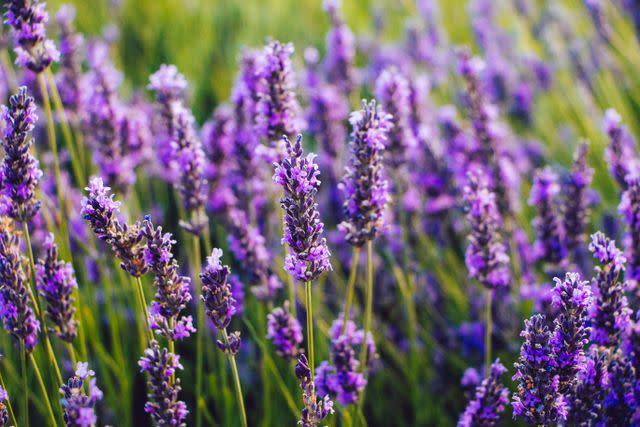
Asife / Getty Images
What would a cottage garden be without lavender? This hardy herb can handle sun and prolonged droughts and grows almost anywhere. As long as you don’t plant it in a soggy spot, you’ll enjoy its fragrance all summer and through the fall. It is great for borders or anywhere with more than six hours of sun a day.
Zones: 5 to 10
Mature size: 2 feet tall x 1 to 2 feet wide
Care requirements: Full sun; sandy, well-drained soil—be careful not to overwater
Sage
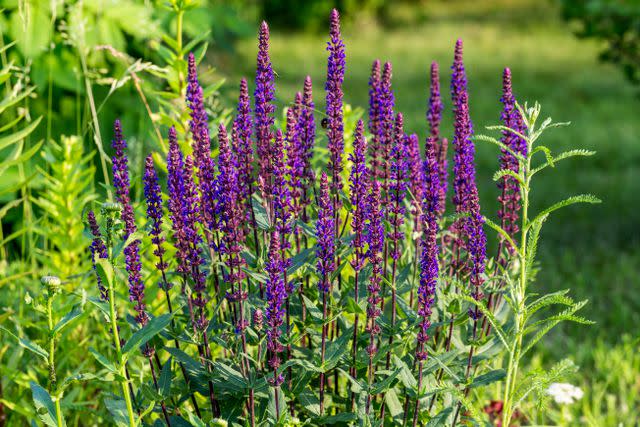
Olga Ionina / GETTY IMAGES
Another cottage garden herb that is important for its culinary uses and fragrant leaves, sage can’t be overlooked. This small perennial, like lavender, enjoys full sun and well-drained soil. Bonus: Its spike of purple tube-like flowers attracts loads of pollinators, which will help keep your garden (and the ecosystem) thriving.
Zones: 4 to 10
Mature size: 2 feet tall x 3 feet wide
Care requirements: Full sun, well-draining soil, water moderately
Related: How to Grow a Kitchen Garden That Fulfills All Your Culinary Needs
Roses
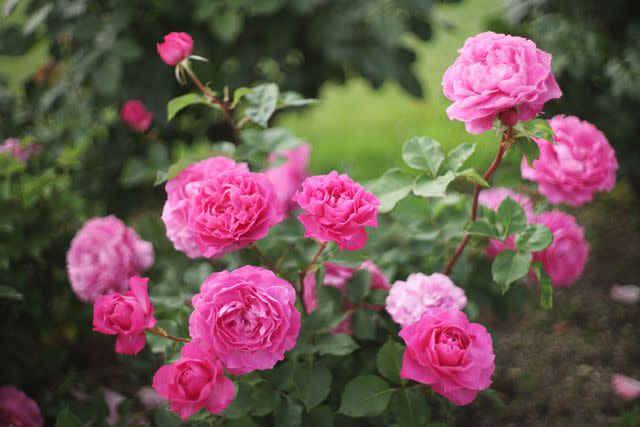
Masako Ishida / Getty Images
Roses need full sun and not a lot of water, but the best part about them is they can tolerate a wide range of temperatures, depending on the variety. They’re beautiful in a cottage garden as a hedge or as a standalone centerpiece that you can lean in and smell when in full bloom.
Zones: 3 to 11
Mature size, shrub: 3 to 5 feet tall
Mature size, climbing: Up to 11 feet tall
Care requirements: Full sun; light watering; slightly acidic, well-draining soil
Related: How to Grow and Care for All the Roses in Your Garden
Clematis
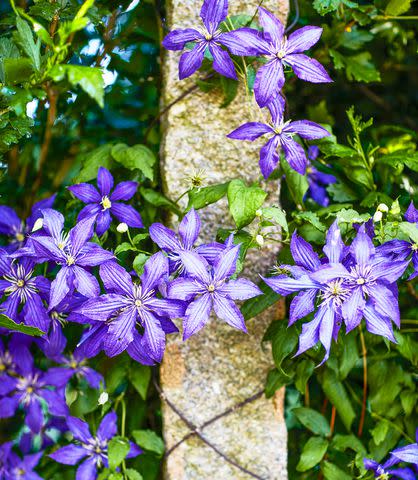
Who wouldn’t love this beautiful vining plant that will shower your garden with fragrant blooms from early summer to fall? Clematis comes in a range of colors and can be woven on a trellis to create a dramatic shape or arch. They do need to be pruned and regularly watered, but it’s worth it for large, showy flowers all season long.
Zones: 3 to 10
Mature size: 7 to 10 feet tall
Care requirements: Full sun; pH neutral soil; water moderately
Related: 13 Best Climbing Plants for Your Backyard Pergolas, Fences, and Trellises
Coneflowers
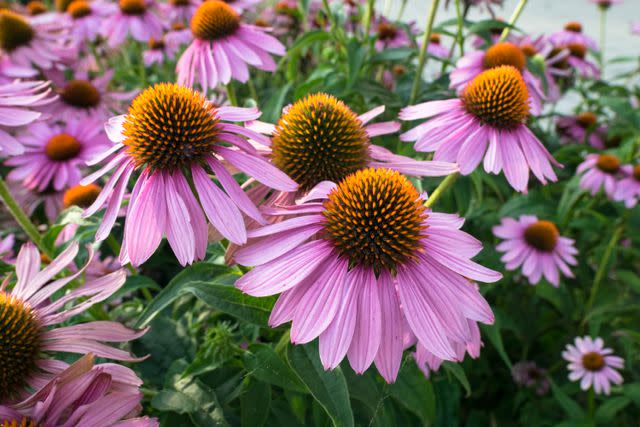
Getty Images
A pollinator favorite, coneflowers are native to North America and have big, wide flowers in yellows, purples, reds, and whites. Laura Janney, garden designer and owner of The Inspired Garden, recommends that coneflowers be placed in the mid-layer of a garden for the best effect. "Coneflower is a prolific bloomer," says Janney. "Once it starts blooming, it could last all the way into frost. It makes a wonderful cut flower so you can enjoy it inside and outside the home."
Zones: 3 to 9
Mature size: 3 to 4 feet tall by 1 foot wide
Care requirements: Full sun; well-draining soil; water moderately
Peonies
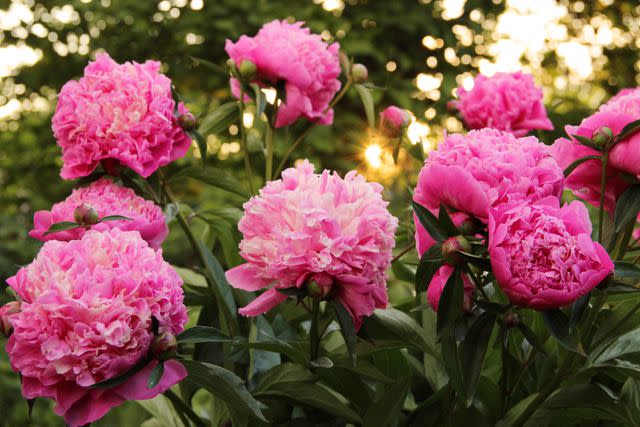
Jasenka Arbanas / Getty Images
You’re probably most familiar with the herbaceous form of peony—a dense shrub with fragrant globe-like blooms in whites, pinks, yellows, and reds. Though peonies only bloom for a couple of weeks, different varieties bloom during different parts of the season, so if you plant it right, you could have peony blooms all summer long.
Zones: 3 to 8
Mature size: 1 to 3 feet tall x 1 to 3 feet wide
Care requirements: Full sun; well-draining soil; water moderately
Related: How to Grow and Care for Peonies to Ensure Beautiful Blooms Year After Year
Thyme
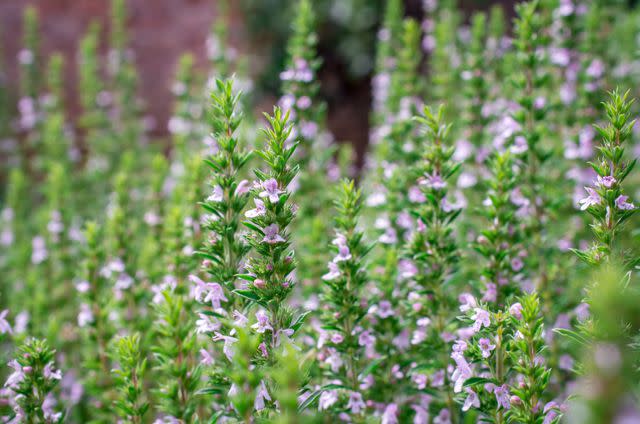
A low-growing hardy herb, thyme is a great plant to put in a dry, sunny patch of the garden next to plants with taller flower spikes. If you’re a bit of a home chef, you can plant this next to rosemary, lavender, or sage plants (though rosemary will be an annual in cooler zones). Just make sure you don’t overwater, or you could cause the roots to rot.
Zones: 5 to 9
Mature size: 4 to 5 feet tall x 3 to 4 feet wide
Care requirements: Full sun to part sun; well-draining soil; water lightly
Salvia
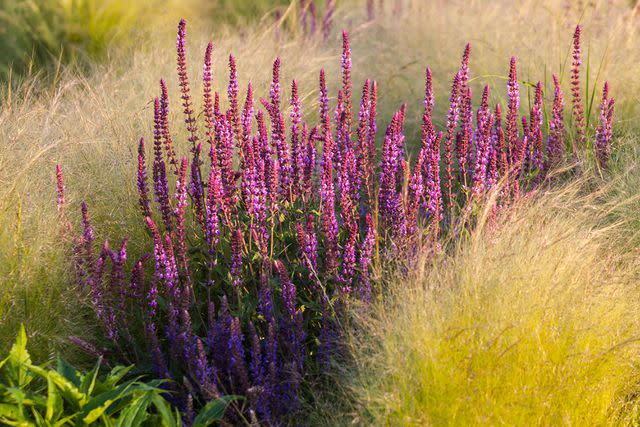
Getty Images
If there’s one plant that will grow anywhere and be happy, it’s salvia. "Salvia is a wonderful plant because it’s hardy, reliable, and an early spring bloomer," says Janney. "It’s great to have some color when most of the perennials haven’t bloomed yet." These are great pollinator plants, come in a range of colors, and are usually disease-free, making them a good choice for a beginning gardener.
Zones: 3 to 9
Mature size: 18 inches to 5 feet tall x 1 to 4 feet wide
Care requirements: Full sun to part sun; well-draining soil; moderate watering
Astilbe
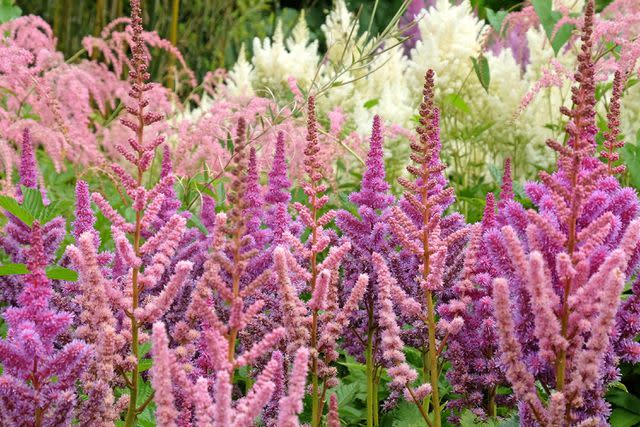
Alex Manders / Getty Images
Flowering later in summer through the fall in many areas, astilbe has fluffy flowers in pinks, whites, and reds. They aren’t tolerant of full sun and likely would work best at the edge of a garden in the shade. Because they flower later in the season, the dead blooms can add winter interest to a garden that’s otherwise brown.
Zones: 3 to 9
Mature size: 3 feet tall x 2.5 feet wide
Care requirements: Part sun to shade; well-draining soil; water heavily
Related: 14 Perennial Plants With Long-Lasting Flowers
Poppies
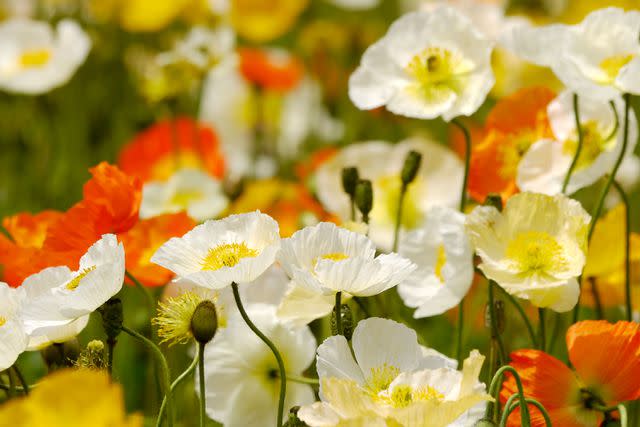
Getty Images
Easily grown from seed, poppies can be either annual or perennial, depending on the species, and the flowers come in every color. Tall stems with big, showy flowers in all colors make poppies a beautiful cut flower for an indoor arrangement. Deadheading poppies also encourage the plant to send up more flower spikes through the season.
Zones: 2 to 9
Mature Size: 3 to 4 feet tall x up to 18 inches wide
Care requirements: Full sun; well-drained soil; water lightly
Related: How to Plant and Care for Poppies, Hardy Flowers That Add Seasonal Interest to Your Garden
Alyssum
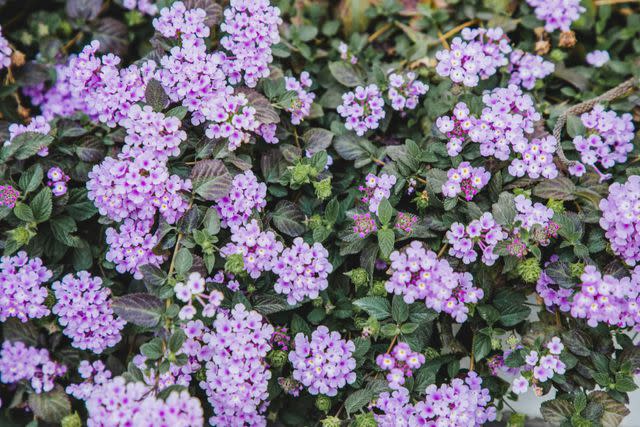
Kilito Chan / Getty Images
This low-lying plant smells wonderful and adds variety when paired with taller background plants like foxgloves or delphiniums. Alyssum will stay less than a foot tall and will spread to any sunny spots as a ground cover plant. This is an annual plant unless you live in zone 9 or 10, but will likely reseed itself where planted and come back year after year.
Zones: 5 to 9
Mature size: 9 inches tall x 4 inches wide
Care requirements: Full sun; well-drained soil; moderate watering
Related: 12 Ground Cover Plants That Will Fill in Negative Space and Suppress Weeds in Your Garden
Pincushion
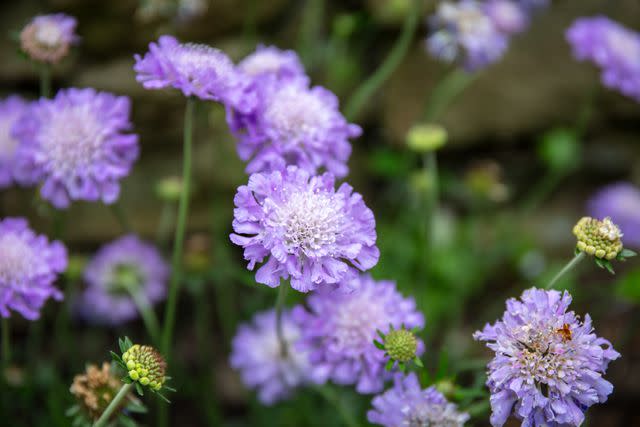
Getty Images
This annual plant gets its name from its globular blooms that resemble a pincushion. Also known as scabiosa, it is a low-maintenance plant that will attract pollinators for months. "With deadheading, it will bloom all season," says Janney. To deadhead, she recommends cutting back spent blooms to the crown or the next set of leaves.
Zones: 3 to 7
Mature size: 2 to 3 feet tall x 1 foot wide
Care requirements: Full sun; well-draining soil; light watering
Yarrow
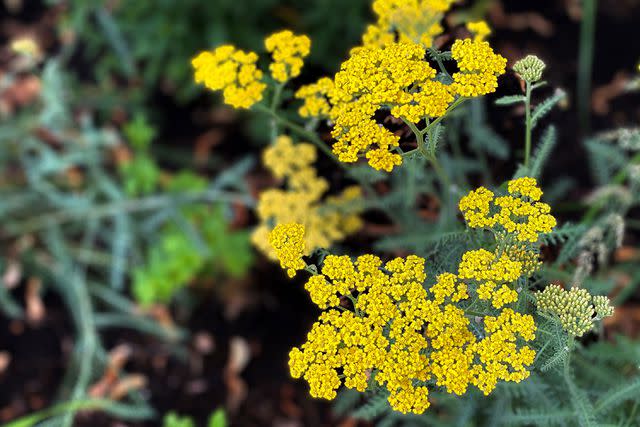
Getty Images
A native to the Americas, yarrow (or milfoil) is a hardy perennial with fragrant blooms. "Its fuzzy leaves create a gorgeous texture," says Janney. She recommends using the sturdy New Vintage variety to prevent the plant from flopping as easily and for a longer bloom period. You should also deadhead once the yarrow is done with its first round of blooming to encourage more blooms into late summer.
Zones: 3 to 9
Mature size: 3 feet tall x 3 feet wide
Care requirements: Full sun; well-draining soil; moderate watering
Related: 15 Fall Flowers That Will Keep Your Garden Blooming All Season Long
Foxglove
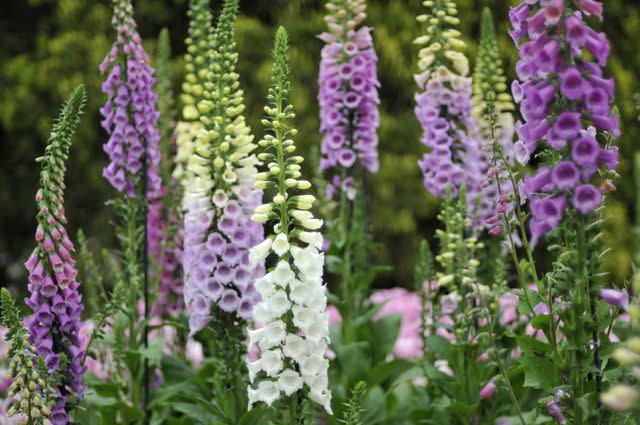
aimintang / Getty Images
It would be a shame to have a cottage garden and not have foxglove included with its 3- to 4-foot-tall flower spikes in any number of colors. Foxgloves are generally pest-resistant and, in general, won’t be taken down by wildlife like deer or rabbits. This plant is toxic, though, so you may want to keep it away from any herbs you grow so as not to confuse the two.
Zones: 4 to 9
Mature size: 2 to 5 feet tall x 1.5 feet wide
Care requirements: Full sun to part shade; well-draining soil; light watering
Penstemon
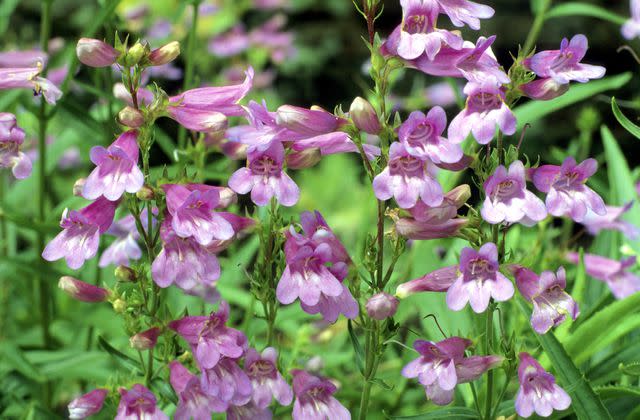
Also known as bearded tongue, penstemon is native to North America and produces large spikes with smaller tubular blooms in a range of colors. The leaves can be dark purple, adding contrast to a sea of green. These plants are heat and drought-tolerant and don’t need extra fertile soil to be happy.
Zones: 4 to 9
Mature size: 1 to 2 feet tall by 1 to 2 feet wide
Care requirements: Full sun to part shade; light watering; well-draining soil
Read the original article on Martha Stewart.

